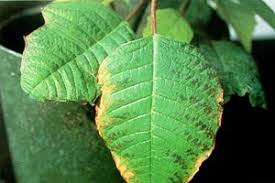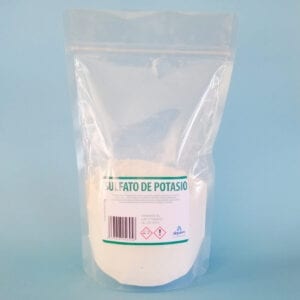The potassium sulphate or potassium sulphate is a compound that is widely used as a fertiliser of various crops, since it is a major source of potassium. Potassium is one of the 12 main nutrients that plants need to grow.
Potassium sulphate as a fertiliser
Potassium is a fairly common element in nature. It is found on the surface of clays and in the various layers of clay, but it is hardly absorbed by plant roots in this way. Potassium can also be obtained from the soil through bacterial degradation, but this process is very slow and insufficient for the levels required in a crop. It is therefore necessary to make a extra potassium. One of the most common ways of doing this is through Potassium Sulphate
Potassium in Plants
Function of potassium in plants
The potassium is one of the 12 main nutrients that plants need. Potassium in particular, along with nitrogen and phosphorus, is one of the 3 nutrients that plants need in the greatest quantity.
The presence of potassium in plants fulfils important functions such as the following:
- It forms sugars: Good potassium concentration is the characteristic that allows one fruit to be sweeter than another; so, if the taste of fruits or vegetables is somewhat acidic, it is probably lack of potassium.
- Stimulates the water content of the cells, and this fact is therefore closely related to the fattening and quality of the fruit. It also has a controlling effect on the permeability of the cell membranes. Less water loss means better preservation of fruit and vegetables. In this way, potassium is involved in the fattening and quality of the fruit, as well as its water content, which allows a better preservation of fruit and vegetables.
- Potassium also helps the absorption of other nutrients such as nitrogen, phosphorus and iron.
- Increased plant resistance: Potassium contributes to the plant's resistance to cold and excessive heat; it is also strengthened in the presence of insects and diseases.
Symptoms of Potassium deficiency
Potassium deficiency can be observed The green leaves turn yellow and the edges and tips of the older leaves dry out. In potassium deficient plants, the potassium content is reduced. flowering and development of the whole plant.

When to fertilise with Potassium Sulphate
Potassium sulphate is one of the most commonly used forms of potassium supply in crops. Its use is motivated by the detection of a lack of potassium in plants or on a regular basis due to one of the following situations
- When the main soil deficiency is potassium or potassium levels are adequate and we need to replenish the potassium consumed by the plants.
- When crops consume high amounts of potassium, as in the case of tomato or paprika cultivation, for example.
- When the pH of an alkaline soil is to be reduced.
- In the case of sandy soils, potassium deficiency is very common, because the rain washes the potassium away from the roots. A constant soil survey is always advisable.
- In aquarium plants it is especially important because potassium cannot be obtained from other sources. You can read more at Potassium Sulphate in Aquarium Plants
Constituents Potassium Sulphate Fertiliser
| Chemical properties | |
| Chemical formula | K2SO4 |
| Content K20 | 48-53% |
| Sulphur content | 17-18% |
| Solubility in water (25°C) | 120 g/l |
| pH of the solution | 7 |
Dosage Potassium Sulphate Fertiliser
In order to know the potassium sulphate requirements of a certain soil, it is necessary to carry out a soil study and to receive a prescription from a technician or agronomist. As a guideline, the following table can be used for potassium sulphate management:
| Level of K and S
on the ground |
Required dose of sulphate of potassium | |
| Granular | Soluble powder | |
| Very low | 150-200 Kg/ha | 1 Kg/200litres |
| Under | 100-150 Kg/ha | 750gr/200litres |
| Medium | 50-100Kg/ha | 500gr/200litres |
| High | It does not require | It does not require |
Buy Potassium Sulphate
-
Potassium Sulphate
5,90€ – 59,00€
